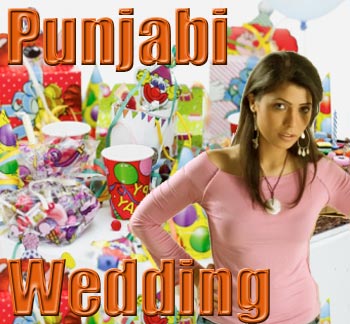Punjabi weddings are elaborate events, marked by singing and dancing. They usually gather in front of the Guru Granth Sahib, though they do follow Hindu rituals like pheras, kanyadhan etc. They follow a lot of rituals and try to stick on to all the rituals from the good old days.
Pre-wedding rituals
Rokka: This ceremony confirms the relationship between the boy and the girl. This ritual is held in the bride's house. Members from the groom's family come over to the bride's house and exchange gifts.
Sagan and chunni chadana: A havan is performed and the bride's father applies tilak on the groom's forehead. Gifts are given to the groom and his family members. The bride dresses up in the clothes and jewelry presented to her by the groom's family. The groom's mother feeds milk and cooked rice to the bride following which the bride and the groom exchange rings.
Sangeet: A sangeet (music) session is held, friends and relatives of both the bride and the groom are invited. Traditional wedding songs are sung during this event.
Mehandi: Mehandi to be applied for the bride is sent by the groom's mother. A professional person applies mehandi on the bride's hands and feet. Close relatives and friends of the bride's family attend this ritual; mehandi is applied on their hands too.
Wedding day rituals
Chuda ceremony: The bride's maternal and aunt play a major role in this function. A havan is performed and the bride is given red and ivory colored bangles. The bride wears a bangle made of iron; it symbolizes good luck for her future. The bride's maternal uncle, aunt and other elders tie kaliras (silver, gold, or gold plated ornaments tied to the chuda) to the bangles. The bride taps unmarried girls with this kalira before leaving to the groom's house.
Ghara ghardoli and vatna: The bride stays within the premises of her house for a couple of days prior to the wedding wearing some old clothes. She is seated next to oil lamps and her siblings bring water from a nearby temple for her bath. Prior to her bath, uptan or vatna (paste of turmeric and mustard oil) is applied on her body. This ritual is performed at the groom's house too.
Sehrabandi: A puja is done after the groom wears his wedding clothes and the sehra or turban that the groom is supposed to wear is blessed by the elders.
Ghodi, vag goodti, duppata varna: The groom's sister-in-law (brother's wife) applies kajal for his eyes, the groom's sister and cousins decorate and feed the mare on which the groom's baraat leaves.
Milni: After the baraat reaches the wedding location, the groom and his family are welcomed with garlands by the bride's family. The bride's family gives shagun to the relatives of the groom.
Wedding rituals
Varmala: The bride and the groom exchange garlands.
Pheras: With the muhurath approaching, the priest makes the groom perform a puja for which he removes his sandals. His sandals are hidden by the bride's sisters and they demand gifts to return the slippers (jhootha chupaai). After this the bride's father gives her hands in the groom's hands (kanyadhaan) after which the pheras are taken. The bride wears clothes and jewelry gifted to her by her in-laws.
Post-wedding rituals
Vidaai: The bride leaves to the groom' house from her parent's house. She throws puffed rice over her head symbolically wishing the best for her parents.
Aarti: Aarti is performed by the groom's mother with a pitcher of water. The bride enters the house after kicking the mustard oil that is kept at the entrance. The bride takes the blessings from her elders (matha tekna).
Phera dalna: The newly wed couple goes to the bride's house the very next day after the wedding and gifts are given to them.
The Punjabi bride wears a sharara, a long flowing skirt and blouse. She wears a dupatta to cover her head. The bride's dress is usually bright colored like red, orange, magenta, etc. The dupatta she wears is adorned with heavy embroidery. The groom wears a sherwani or the traditional salwar and kurta. Punjabi wedding feasts are elaborate and involve many a rich delicacy.

















